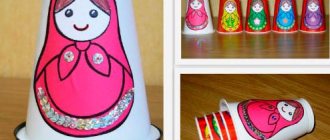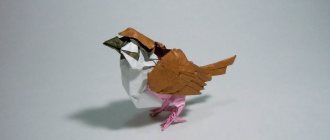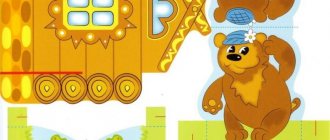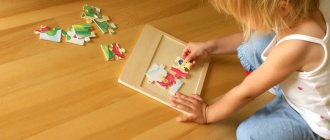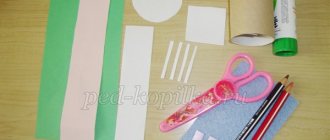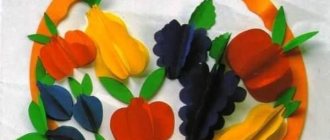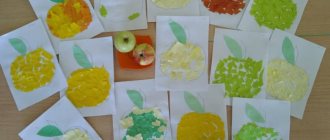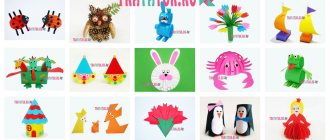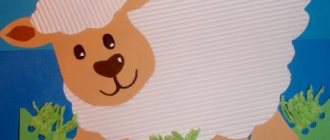Features of the Russian nesting doll
There are several options regarding how to make a matryoshka doll from paper. At the same time, the products can represent not only standard Russian nesting dolls, but also more original ideas that represent animals and other characters in the form of prefabricated structures. Children of different age groups in kindergartens and primary schools can work on this type of craft.
- What kind of crafts exist in the form of nesting dolls?
- Examples of ready-made crafts
- Creating crafts based on the child’s age
- Required materials and tools
- Junior group (2-4 years)
- Average (4-5 years)
- Senior (5-6 years old)
- Preparatory (6-7 years old, preschoolers)
- Varieties of crafts with assembly instructions
- Step-by-step assembly of a matryoshka cat
- Origami with diagram
- Applications for children
- Cutting templates
- Volumetric craft using modular origami technique
- Eyes and lips to print and cut out
- Video master class
- Design ideas
What kind of crafts exist in the form of nesting dolls?
There are several methods and types of nesting dolls, which may be presented in the standard sense or may be far from the norm. Here are several options for paper dolls:
- Russian nesting doll (flat or three-dimensional);
- nesting dolls in the form of animals;
- folding version of the set with the faces of family members;
- nesting dolls in the form of plants or objects.
If the Russian nesting doll is recognizable in any form, then when making this type of crafts in the form of animals, plants, people, it is worth observing the most important feature - the ability to assemble from the smallest element to the largest.
Examples of ready-made crafts
There are many ways to make matryoshka dolls from paper. At the same time, they can look very peculiar. Examples of the most interesting works:
- Forming a paper figurine on a disposable glass to recreate the volume.
- Funny three-dimensional matryoshka dolls consisting of several parts.
- A flat, prefabricated structure consisting of several elements, preserving the basic principle of the toy.
You can give a lot more examples and finished works, each of which is the result of the manifestation of boundless imagination and the properties of paper as a base material.
Maneki-neko in paper version
Usually matryoshka cats are made of wood. But even if they are made of paper using the origami technique, they are unlikely to lose their “magic” functions. For the Japanese talisman “for good luck” you will need 4 square sheets of different colors, sizes 15x15, 13x13, 11x11 and 9x9 cm.
Step-by-step instruction:
- We take the largest square blank.
- We place it with the top forward, fold it in half from bottom to top.
- We bend the left corner obliquely so that its top “rests” against the opposite edge.
- We do the same with the right one.
- Fold the top layer of the triangular flap forward.
- We tuck it into the lower trapezoidal “pocket”.
- We bend the second layer of the valve. We put it inside the resulting “glass”.
- Turn the workpiece 180°. We press our finger on the upper part of it to mark the ears. We draw the cat's face, as well as a tail and paws. According to Japanese tradition, one of them can be raised to attract good luck.
With a paper maneki-neko, young children will be able to act out theatrical scenes, inventing their own character for each member of the cat family. So, along with logic, an unusual nesting doll will allow you to develop your imagination.
If maneki-neko seems too exotic, the same scheme is suitable for making a classic Russian origami matryoshka doll. There is no need to press the figure with your finger at the top. The rest of the assembly algorithm is absolutely identical.
Design ideas
We decorate the nesting doll in accordance with any preferences and desires. The base can be cardboard or thick colored paper, but for decoration it is easy to use accessories, rice, beans, beads, and plasticine.
Other decorative principles can be used. Naturally, you can also use colored paper to work on the decoration.
Making a matryoshka doll with your own hands is quite simple - just determine the child’s skills and abilities, and then choose the appropriate operating algorithm. At the same time, you can create three-dimensional and flat figures of various shapes and colors. When working on a craft of this type, it is worth using bright colored paper, since the product must have folk motifs in its decor.
Summary of direct educational activities in the senior group “Matryoshka”
Lesson notes on the application “Matryoshka”
MBDOU No. 62 “Rodnichok”
Authors: Kazachkova Elizaveta Sergeevna - teacher,
Dvoretskaya Elena Arkadyevna - teacher
Age:
senior group
Subject:
"Matryoshka"
Purpose of the lesson:
To promote the ability to create an image of a folk toy (matryoshka) using the appliqué technique.
Tasks:
1. Teach children to analyze a sample to identify characteristic features
(Components: face, hands, sundress, scarf)
2. Teach children to consciously select matryoshka parts in the chosen color scheme.
3. Continue training in work planning.
4. Teach how to capture an idea in an original artistic image.
5. Continue teaching how to cut out an object using a stencil and carefully stick on the applique elements
Equipment:
paper, fabric, glitter, scissors, glue, brush, pencil.
Bibliography:
Arapova S.V. Fine arts training. Integration of artistic and logical. - St. Petersburg: KARO, 2004. - (Modernization of general education).
Gusakova M. A. Application. - M.: Education, 1982.
Dubrovskaya N.V. Invitation to creativity: teaching preschoolers the technique of appliqué and collage. - St. Petersburg: “CHILDHOOD-PRESS”, 2004. - 128 p.
Progress of the lesson:
Organizing time.
Hello guys.
What could such a box be filled with?
Of course, with old Russian things. I'll tell you a secret. The box is filled with toys.
So, let's open the box? I'm looking for a wonderful toy. Guess which one?
We're at the fair
They brought you a chest - a gilded barrel. That chest is not simple, and the goods in it are painted. We take it out for display - And we tell a story about it.
A scarlet silk scarf, a bright sundress in a flower, resting the hand on the wooden sides. And inside there are secrets: Maybe 3, or maybe 6. She didn’t blush a little (children’s answers...? Matryoshka)
Presentation and conversation.
Now I’ll tell you guys about this wonderful toy – a matryoshka. After all, you probably have such a house and a toy?
Who has?
The first Russian matryoshka was an eight-seater: a girl with a black rooster was followed by a boy, then a girl, and so on. All the figures were different from each other. The last one, the eighth, depicted a baby.
Initially, this doll didn’t even have a name. But when the turner made it out of wood, the artist painted it with bright colors, then the name appeared - M?atryona. Perhaps this is due to the fact that at various evenings tea was served by a servant with that name. Why was everyone’s favorite Russian doll-toy called “matryoshka”? Many believe that this name comes from the female name Matryona, very popular at that time in Russia. The name Matryona, translated from Latin, means “noble woman.” Looking at the matting doll, the image of a portly, noble and toy really appears.
This is interesting
Folding figurines “small small less” have an ancient history. They were found both in Rus' and among other nations; just remember the Chinese carved puzzle “ball in a ball” or elephants, popular in India, which, although they were not assembled into a single toy, were also lined up from large to small. All these “funs” were nothing more than a symbolic model of the Universe. Scientists have proven that outer space is built according to the “matryoshka” principle: stars and planets consist of a core enclosed in a shell, in turn, enveloped in a gaseous environment. Cosmic bodies form galaxies, giving rise to clusters, the multitude of which are called the Universe. It is already known that it is not alone, but is also “embedded” in larger structures, still unknown to humanity.
On the other hand, unlike its analogues, the Russian nesting doll is also a symbol of motherhood and procreation. The imagery here is clear without words. The name of the toy probably comes from the Sanskrit "Matri", meaning "mother". The folding doll gained great popularity in the 19th century, when interest in folk traditions increased in Russian society and many crafts began to be revived on this wave. The international recognition of the nesting doll was promoted by the prominent merchant and philanthropist Savva Mamontov. In 1900, he presented a unique toy at the World Exhibition in Paris, causing not only general admiration, but also a real fashion boom. Orders for the mysterious nesting doll from distant Russia then poured in one after another.
Two images of the legendary toy
The first to mass produce matryoshka dolls were the artisans of Sergiev Posad in the Moscow region. At the beginning, the samples were a mother with a large family, sometimes including only daughters, and sometimes both boys and girls. However, soon the painting of wooden dolls became much more diverse - townspeople artists depicted artisans and merchant women, young girls in bright city outfits and old men in traditional peasant clothes.
Special series were dedicated to literary works, folk tales, important historical events, and so on. The blanks were painted by local icon painters, drawing on the traditions of the Byzantine school of painting. If the first toys had a simplified appearance, then later they began to resemble the faces of saints, and the stories that adorned them became more complex.
Since the beginning of the 20th century, nesting dolls began to be produced by the leading center of folk crafts - the city of Semenov in the Nizhny Novgorod region. The artel of the master Arseny Mayorov gave preference to dolls in the Russian style, which quickly came from Sergiev Posad. To understand what the products of Semyonovsky craftsmen looked like, it is enough to remember that the city is the birthplace of the famous Khokhloma. The techniques for painting nesting dolls were borrowed from there. Particular attention was paid to the decor of the toy’s apron, which became an integral part of her outfit. The painting was dominated by plant motifs - stylized flowers, herbs and berries.
Over time, the appearance of the folk doll has changed several times. During the era of perestroika, a fashion appeared for folding models with portraits of political figures and other equally grotesque products. However, these phenomena are transitory, and the wooden folding toy, a masterpiece and phenomenon of Russian culture, not only continues to live, but is also reflected in related types of needlework. For example, in origami.
